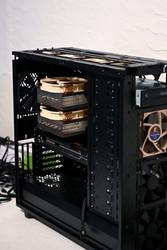Cooling Solutions and Power Management: A Guide to Server Efficiency
Every tech-savvy worker looks for ways to improve server performance and reduce disruptions in the world of IT, where server downtime can result in significant losses. We'll delve into some insider hints and strategies for server maintenance, cooling options, and power management in this blog post. These tips will assist you in extending the life of your server's components and maintaining the efficiency of your systems.
Server Maintenance Tips:
- 1.Regularly Update Firmware and Drivers: For optimum performance and security, it's essential to keep your server's firmware and drivers up to current. Updates are released by manufacturers to fix bugs, increase compatibility, and improve features. Make this a regular component of your server upkeep.
- 2.Implement a Scheduled Cleaning Regimen: Servers may become clogged with dust and dirt, which can lead to overheating and decreased airflow. Keep server parts clean on a regular basis, paying close attention to fans and heat sinks. Before cleaning, make sure the server is turned off and disconnected from the power supply.
- 3.Monitor Server Health: Use server monitoring tools to keep an eye on the performance and health of your system. These tools enable proactive maintenance by warning you of potential problems before they develop into serious ones.
- 4.Keep Spare Parts Handy: In the event of a component failure, keeping a stock of essential spare components, such as power supplies and hard drives, helps minimise downtime. Having these components on hand can save lives in an emergency.
Cooling Solutions:
- 1.Optimize Server Room Temperature: It's crucial to keep your server room at the optimum temperature. To avoid overheating, maintain the room's temperature within the acceptable range for your server gear. If necessary, think about utilising a specialised cooling system.
- 2.Arrange Server Rack Layout Strategically: Server racks should be properly arranged to guarantee effective airflow. Servers should be placed so that hot air from one server doesn't enter the intake of another. To encourage airflow, use blanking panels and cable management techniques.
- 3.Install Temperature and Humidity Sensors: Sensors for temperature and humidity can offer real-time information about the climate in your server room. With the help of this information, you can alter things as needed to keep the server environment steady.
Power Management Tips:
- 1.Implement Redundant Power Supplies: Redundancy offered by two power supplies makes sure your server keeps running even if one fails. High availability relies critically on this redundancy.
- 2.Utilize Uninterruptible Power Supplies (UPS): In order to protect against power fluctuations and outages, UPS devices are used. In the event of a power outage, they provide valuable time to preserve work and gracefully shut down servers.
- 3.Configure Energy-Saving Features: Utilise the energy-saving capabilities of your server's operating system and hardware. Through these characteristics, power usage can be decreased when there is less activity.
You can lengthen the lifespan of your server components, reduce downtime, and make sure that your IT infrastructure is dependable and effective by using these tech tips and tricks for server maintenance, cooling, and power management. Keep in mind that a robust server is the foundation of an efficient digital environment. If you like these blogs, head over to our website for more.
Recent Posts
-
A Comprehensive Comparison of Compaq Hard Drives
Choosing the right hard drive for your computing needs is crucial for optimal performance and relia …Apr 25th 2024 -
TechnoDeal’s Hard Drive Series – Noteworthy NetApp Hard Drives
NetApp is a reputable brand in the field of enterprise storage solutions, offering cutting-edge sto …Mar 24th 2024 -
Dell's Storage Marvels: A Comprehensive Guide to Optimal Storage Solutions
For the best performance and dependability in the constantly changing world of data storage, sele …Feb 23rd 2024


